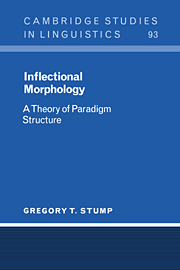4 - Headedness
Published online by Cambridge University Press: 14 October 2009
Summary
Introduction
In the Bulgarian analysis developed in chapter 2, the individual realization rules function as parts of the definition of a single overarching paradigm function. In this chapter, I present an extended argument motivating the postulation of paradigm functions in morphological theory; in particular, I show that an adequate theory of inflectional head marking necessitates their postulation.
The usual expectation is that a word's inflectional markings will be linearly outside of any derivational or compounded formatives which that word contains. Nevertheless, there is a large and systematic class of counterexamples to this generalization. For instance, Sanskrit has a set of preverbs (which generally also serve independently as adverbs or adpositions) which can be combined with a verb to form a new, compound verb: thus, the verb root pat- ‘fly’ combines with the preverb ni ‘down’ to produce the compound verb root ni-pat- ‘fly down’ as this example suggests, the preverb usually has the semantic effect of an adverb (though in many instances the compound has an idiosyncratic meaning not directly deducible from the meanings of its parts, e.g. pra ‘forward, forth’ + labh- ‘to seize’ → pra-labh- ‘to deceive’). When a compound verb root inflects, the inflection is realized on the root heading the compound. This is particularly evident in those tenses that require the preterite prefix a- (the so-called ‘augment’). Thus, in the 3sg imperfect active form of ni-pat-, the inflectional marking is linearly inside of the compounded formative ni: ny-a-patat.
Information
- Type
- Chapter
- Information
- Inflectional MorphologyA Theory of Paradigm Structure, pp. 96 - 137Publisher: Cambridge University PressPrint publication year: 2001
